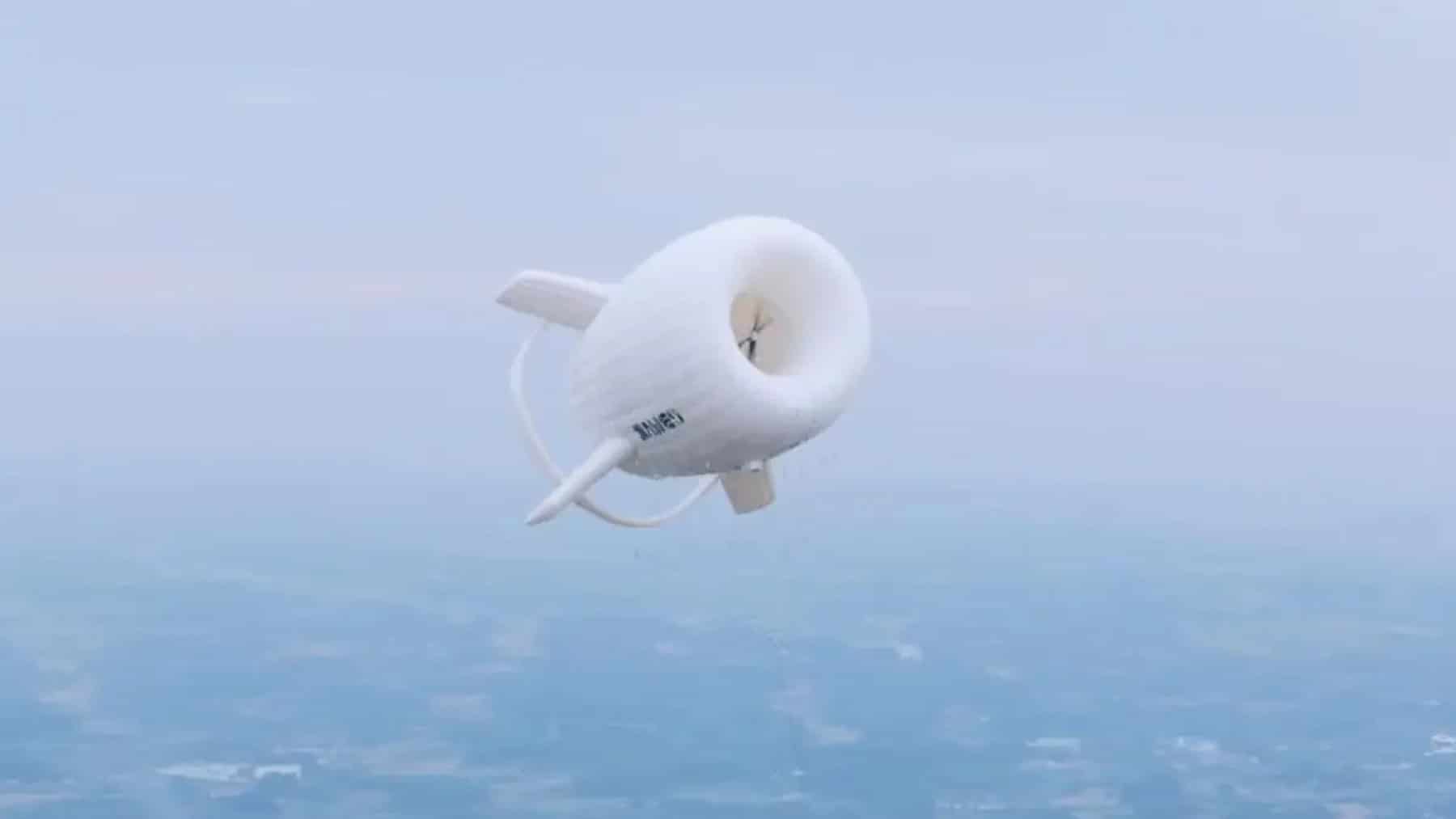Report on Airborne Wind Energy Technology and its Contribution to Sustainable Development Goals
Introduction: A Novel Approach to Clean Energy Generation
A report on the advancements in airborne wind energy (AWE) technology, led by Beijing SAWES Energy Technology Company, highlights a significant contribution towards achieving Sustainable Development Goal 7 (Affordable and Clean Energy). The development of innovative, airship-like floating wind turbines presents a transformative method for generating renewable energy by accessing previously untapped high-altitude wind resources. This technology represents a major step forward in sustainable energy harvesting, directly supporting global efforts to increase the share of renewable energy in the global energy mix and combat climate change, in line with SDG 13 (Climate Action).
Harnessing High-Altitude Wind for Enhanced Energy Efficiency
Conventional ground-based wind turbines are limited by the intermittent and relatively low-velocity winds found at altitudes up to 656 feet. This constraint restricts their energy generation potential. The floating turbine design overcomes this limitation by operating at significantly higher altitudes, where wind streams are more consistent and powerful. This innovation addresses key engineering and economic barriers that have hindered the exploitation of vast high-altitude wind resources, thereby advancing SDG 9 (Industry, Innovation, and Infrastructure) by creating resilient and technologically advanced energy systems.
The S1500 system, a key model in this development, is designed to operate at an altitude of 4,921 feet. At this height, wind speeds are approximately three times faster than at ground level, potentially yielding a power output up to 27 times greater than a comparable ground-based turbine. Electricity generated is transmitted to a ground station via a high-voltage tether. This enhanced efficiency is critical for accelerating the transition to clean energy as mandated by SDG 7.
Contribution to SDG 9: Innovation and Sustainable Infrastructure
The S1500 system exemplifies progress in sustainable infrastructure with its high power density and minimal ground footprint. Its ability to generate one megawatt (MW) of power is comparable to a conventional 328-foot-tall turbine but requires significantly less land. This efficiency supports the development of Sustainable Cities and Communities (SDG 11) by enabling clean energy generation in areas where land is scarce or unsuitable for traditional wind farms.
Technical Specifications of the S1500 System
- Power Output: 1 megawatt
- Operational Altitude: 4,921 feet
- Weight: Under 2,204 pounds
- Generator Configuration: 12 integrated micro-generators
- Primary Material: Lightweight carbon fiber
Scalable Technology and Future Prospects for Climate Action (SDG 13)
SAWES has demonstrated a scalable and progressive development pathway for its AWE technology. This progression showcases a commitment to continuous innovation in support of global sustainability targets.
- S500 System: Achieved an altitude of 1,640 feet with a 50-kilowatt output.
- S1000 System: Reached 3,280 feet with a 100-kilowatt output.
- S1500 System: Operates at 4,921 feet with a 1-megawatt output.
The long-term vision includes systems operating at altitudes of 32,808 feet to harness the power of jet streams, where wind energy is substantially more potent. Realizing this ambition would represent a revolutionary leap in renewable power generation, providing a powerful tool for global climate action (SDG 13) by drastically reducing reliance on fossil fuels.
Conclusion: A Paradigm Shift for Global Energy Goals
The development of megawatt-scale floating wind turbines marks a paradigm shift in renewable energy technology. By effectively exploiting high-altitude wind resources, this innovation opens new avenues for clean energy production. This groundbreaking solution directly supports the interconnected objectives of the Sustainable Development Goals, particularly SDG 7, SDG 9, and SDG 13, by offering a more efficient, scalable, and less intrusive method for building a sustainable energy future.
Analysis of Sustainable Development Goals in the Article
1. Which SDGs are addressed or connected to the issues highlighted in the article?
-
SDG 7: Affordable and Clean Energy
- The article’s central theme is a new technology for generating renewable energy. It describes an “innovative floating turbine system” designed to change “the way renewable energy is generated.” This directly relates to ensuring access to affordable, reliable, sustainable, and modern energy for all.
-
SDG 9: Industry, Innovation, and Infrastructure
- The text highlights a “groundbreaking” technological advancement and a “paradigm shift in the renewable energy technology.” The development of the S1500 system by Beijing SAWES Energy Technology Company is a clear example of building resilient infrastructure, promoting inclusive and sustainable industrialization, and fostering innovation.
-
SDG 13: Climate Action
- By developing a more efficient method of harvesting wind power, the technology described offers a way to increase clean energy production. The article states that this innovation has “created new avenues to clean energy production” and may help in “making the world go green,” which are crucial actions for combating climate change and its impacts.
2. What specific targets under those SDGs can be identified based on the article’s content?
-
Under SDG 7 (Affordable and Clean Energy):
- Target 7.2: “By 2030, increase substantially the share of renewable energy in the global energy mix.” The article describes a technology that can generate significantly more power (“up to 27 times higher”) than conventional turbines, directly contributing to increasing the share of renewable wind energy.
- Target 7.a: “By 2030, enhance international cooperation to facilitate access to clean energy research and technology… and promote investment in energy infrastructure and clean energy technology.” The development of the S1500 floating turbine is a prime example of promoting investment and advancing research in clean energy technology.
-
Under SDG 9 (Industry, Innovation, and Infrastructure):
- Target 9.4: “By 2030, upgrade infrastructure and retrofit industries to make them sustainable, with increased resource-use efficiency and greater adoption of clean and environmentally sound technologies…” The floating turbine is presented as a more efficient and sustainable technology with a “significantly smaller” footprint and lighter weight compared to conventional installations, embodying the principles of this target.
- Target 9.5: “Enhance scientific research, upgrade the technological capabilities of industrial sectors… encouraging innovation…” The article details the “progressive development” of the technology, from the S500 to the S1000 and now the S1500 system, which demonstrates a clear commitment to scientific research and innovation in the renewable energy sector.
-
Under SDG 13 (Climate Action):
- Target 13.2: “Integrate climate change measures into national policies, strategies and planning.” While not explicitly mentioning policy, China’s leadership in developing such a transformative renewable energy technology implies the integration of climate action goals into its national industrial and technological strategy.
3. Are there any indicators mentioned or implied in the article that can be used to measure progress towards the identified targets?
-
For Target 7.2 (Increase renewable energy share):
- Power Output and Efficiency: The article provides specific metrics like the “1 megawatt” power output of the S1500 system and the fact that its access to higher altitude winds can result in a power output “up to 27 times higher” than ground-based turbines. These figures can be used to measure the potential increase in renewable energy generation.
-
For Target 9.4 (Upgrade infrastructure with clean technologies):
- Resource and Land Use Efficiency: The article implies indicators of resource efficiency by stating the S1500 system has a “significantly smaller” footprint and weighs “much less than 2,204 pounds” while providing the same power as much larger conventional installations. This demonstrates increased efficiency in material and land use.
-
For Target 9.5 (Enhance scientific research and innovation):
- Technological Advancement and Scalability: The “scalable technology demonstrated through progressive development” from the S500 (50 kW) to the S1500 (1 MW) serves as a qualitative indicator of sustained research, development, and innovation. The stated ambition to reach altitudes of 32,808 feet further highlights ongoing R&D efforts.
4. Summary Table of SDGs, Targets, and Indicators
| SDGs | Targets | Indicators (Mentioned or Implied in the Article) |
|---|---|---|
| SDG 7: Affordable and Clean Energy | 7.2: Increase substantially the share of renewable energy.
7.a: Promote investment in energy infrastructure and clean energy technology. |
– Power output of the new technology (1 megawatt). – Increased power efficiency (up to 27 times higher than conventional turbines). – Development of megawatt-scale floating turbines. |
| SDG 9: Industry, Innovation, and Infrastructure | 9.4: Upgrade infrastructure with increased resource-use efficiency and adoption of clean technologies.
9.5: Enhance scientific research and encourage innovation. |
– Smaller physical footprint compared to conventional turbines. – Lighter weight of the system (under 2,204 pounds). – Documented progressive development and scalability (from S500 at 50 kW to S1500 at 1 MW). |
| SDG 13: Climate Action | 13.2: Integrate climate change measures into national policies, strategies and planning. | – Creation of “new avenues to clean energy production.” – Development of technology to help in “making the world go green.” – National leadership (China) in a key renewable energy technology. |
Source: ecoticias.com







